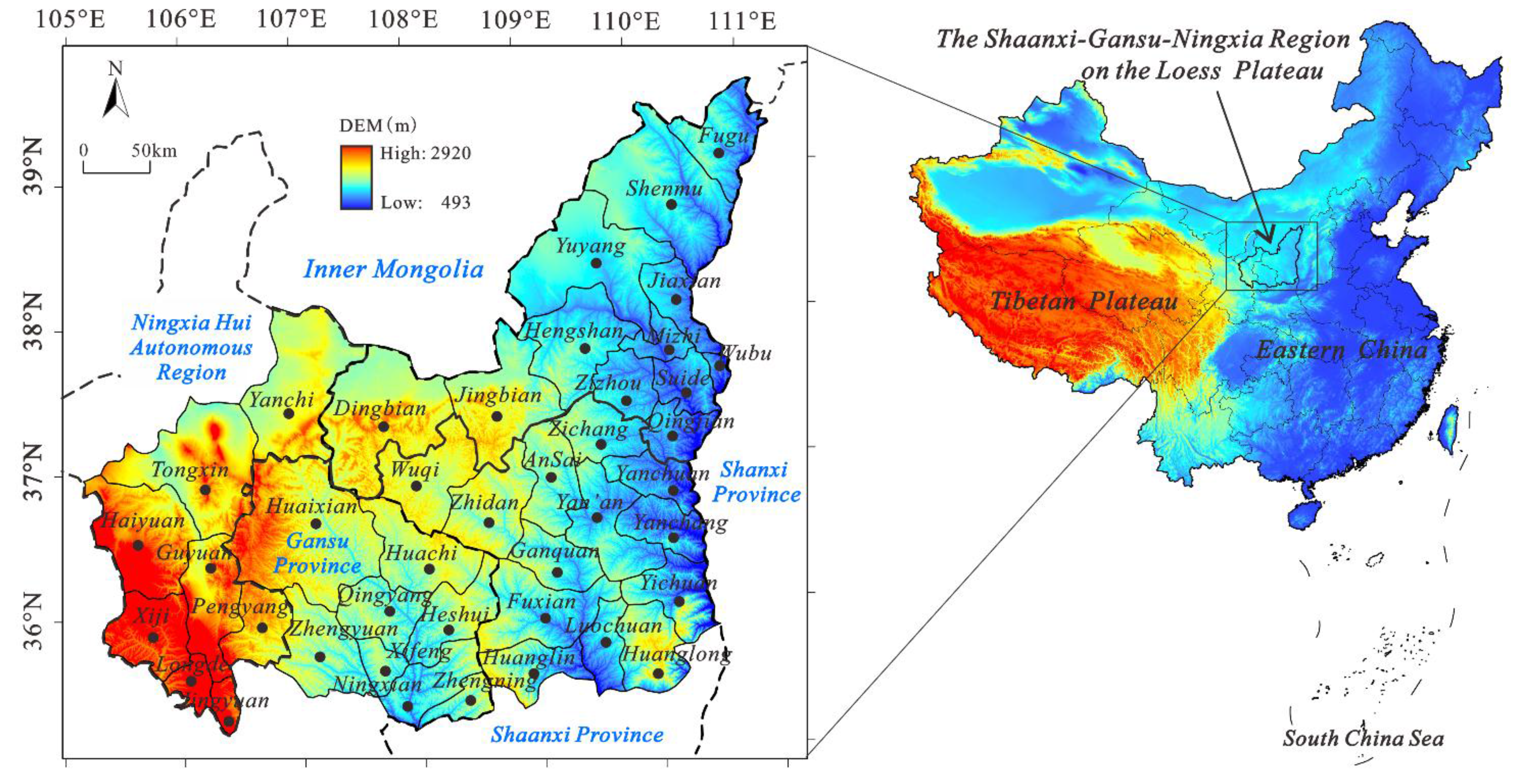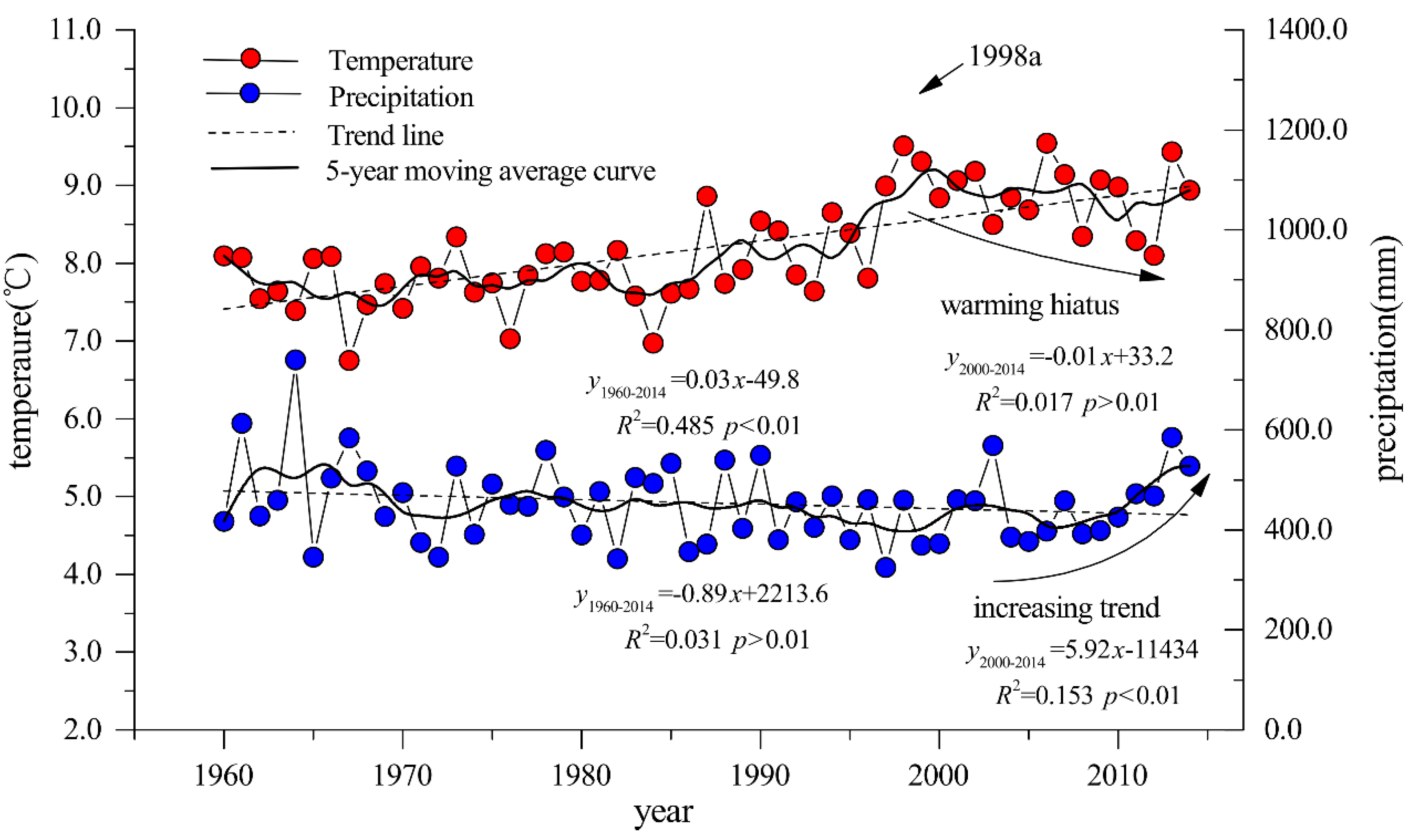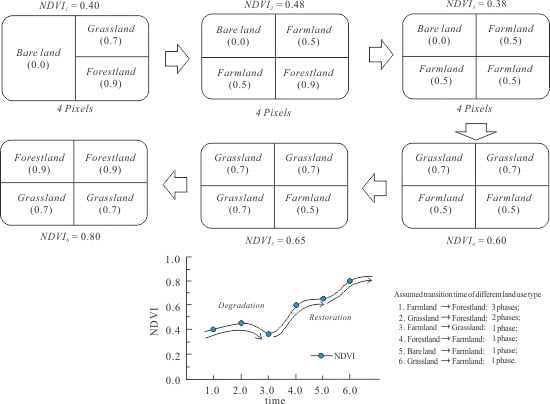NDVI-Based Analysis on the Influence of Climate Change and Human Activities on Vegetation Restoration in the Shaanxi-Gansu-Ningxia Region, Central China
Abstract
:1. Introduction
2. Materials and Methods
2.1. The Study Area

2.2. Data Sources
2.3. Methods
2.3.1. Theil–Sen Trend Estimate Combined with the Mann–Kendall Trend Test
| Classical Standard | Range | Classical Standard | Range |
|---|---|---|---|
| Serious degradation | Slope < −0.0090 | Slight improvement | 0.0009 ≤ Slope < 0.0045 |
| Moderate degradation | −0.0090 ≤ Slope < −0.0045 | Moderate improvement | 0.0045 ≤ Slope < 0.0090 |
| Slight degradation | −0.0045 ≤ Slope < −0.0009 | Obvious improvement | 0.0090 ≤ Slope |
| Unchanged | −0.0009 ≤ Slope < 0.0009 |
2.3.2. Fluctuation Tendency
3. Results and Analysis
3.1. Features of Variation of Average NDVI Values in the Shaanxi-Gansu-Ningxia Region

| ID | Stage | NDVI | Temperature | Precipitation |
|---|---|---|---|---|
| 1 | 2003–2005 | −1.0% | 2.2% | −33.7% |
| 2 | 2007–2008 | −3.4% | −8.7% | −14.8% |
| 3 | 2013–2014 | −0.1% | −5.2% | −9.8% |
| 4 | 2000–2002 | 16.2% | 3.8% | 22.8% |
| 5 | 2008–2013 | 21.3% | 13.0% | 49.3% |
| 6 | 2012–2013 | 6.3% | 16.4% | 24.9% |
3.2. Spatial Patterns of NDVI in the Shaanxi-Gansu-Ningxia Region
3.2.1. Trends in NDVI Change in the Shaanxi-Gansu-Ningxia Region
| Period | Type | Degradation | Unchanged | Improvement | ||||
|---|---|---|---|---|---|---|---|---|
| Serious | Moderate | Light | Light | Moderate | Serious | |||
| 2000–2009 | Patches | 19,647 | 58,267 | 139,050 | 128,048 | 359,689 | 451,316 | 1,398,634 |
| Area (%) | 0.8% | 2.3% | 5.4% | 5.0% | 14.1% | 17.7% | 54.7% | |
| 2000–2014 | Patches | 3487 | 5368 | 24,081 | 73,065 | 329,926 | 555,593 | 1,563,131 |
| Area (%) | 0.1% | 0.2% | 0.9% | 2.9% | 12.9% | 21.7% | 61.2% | |

3.2.2. The Stability of NDVI Changes in the Shaanxi-Gansu-Ningxia Region

3.2.3. The Influence of Human Activities and Climate Change on Vegetation Restoration



4. Conclusions
5. Future Studies

Supplementary Files
Supplementary File 1Acknowledgments
Author Contributions
Conflicts of Interest
References
- Root, T.L.; Price, J.T.; Hall, K.R.; Schneider, S.H.; Rosenzweig, C.; Pounds, J.A. Fingerprints of global warming on wild animals and plants. Nature 2003, 421, 57–60. [Google Scholar] [CrossRef] [PubMed]
- Krishnaswamy, J.; John, R.; Joseph, S. Consistent response of vegetation dynamics to recent climate change in tropical mountain regions. Global Chang. Biol. 2014, 20, 203–215. [Google Scholar] [CrossRef] [PubMed]
- Wu, D.H.; Zhao, X.; Liang, S.L.; Zhou, T.; Huang, K.C.; Tang, B.J.; Zhao, W.Q. Time-lag effects of global vegetation responses to climate change. Global Chang. Biol. 2015. [Google Scholar] [CrossRef] [PubMed]
- Hilker, T.; Lyapustin, A.I.; Tucker, C.J.; Hall, F.G.; Myneni, R.B.; Wang, Y.; Bi, J.; de Moura, Y.M.; Sellers, P.J. Vegetation dynamics and rainfall sensitivity of the Amazon. Proc. Natl. Acad. Sci. USA 2014, 111, 16041–16046. [Google Scholar] [CrossRef] [PubMed]
- Li, A.; Wu, J.G.; Huang, J.H. Distinguishing between human-induced and climate-driven vegetation changes: A critical application of RESTREND in Inner Mongolia. Landsc. Ecol. 2012, 27, 969–982. [Google Scholar] [CrossRef]
- Chen, B.X.; Zhang, X.Z.; Tao, J.; Wu, J.S.; Wang, J.S.; Shi, P.L.; Zhang, Y.J.; Yu, C.Q. The impact of climate change and anthropogenic activities on alpine grassland over the Qinghai–Tibet Plateau. Agric. Forest Meteorol. 2014, 189, 11–18. [Google Scholar] [CrossRef]
- Lü, Y.H.; Zhang, L.W.; Feng, X.M.; Zeng, Y.; Fu, B.J.; Yao, X.L.; Li, J.R.; Wu, B.F. Recent ecological transitions in China: Greening, browning, and influential factors. Sci. Rep. 2015. [Google Scholar] [CrossRef] [PubMed]
- Nowacki, G.J.; Abrams, M.D. Is climate an important driver of post-European vegetation change in the eastern United States? Global Chang. Biol. 2015, 21, 314–334. [Google Scholar] [CrossRef] [PubMed]
- Herrmann, S.M.; Anyamba, A.; Tucker, C.J. Recent trends in vegetation dynamics in the African Sahel and their relationship to climate. Global Environ. Chang. 2005, 15, 394–404. [Google Scholar] [CrossRef]
- Piao, S.L.; Mohammat, A.; Fang, J.Y.; Cai, Q.; Feng, J.M. NDVI-based increase in growth of temperate grasslands and its responses to climate changes in China. Global Environ. Chang. 2006, 16, 340–348. [Google Scholar] [CrossRef]
- Liu, Y.X.; Wang, Y.L.; Peng, J.; Du, Y.Y.; Liu, X.F.; Li, S.S.; Zhang, D.H. Correlations between urbanization and vegetation degradation across the world’s metropolises using DMSP/OLS nighttime light data. Remote Sens. 2015, 7, 2067–2088. [Google Scholar] [CrossRef]
- Miao, L.; Ye, P.; He, B.; Chen, L.; Cui, X. Future climate impact on the desertification in the dry land Asia using AVHRR GIMMS NDVI3g data. Remote Sens. 2015, 7, 3863–3877. [Google Scholar] [CrossRef]
- Cai, H.Y.; Yang, X.H.; Wang, K.J.; Xiao, L.L. Is forest restoration in the southwest china karst promoted mainly by climate change or human-induced factors? Remote Sens. 2014, 6, 9895–9910. [Google Scholar] [CrossRef]
- Xiao, J.F.; Moody, A. Trends in vegetation activity and their climatic correlates: China 1982 to 1998. Int. J. Remote Sens. 2004, 25, 5669–5689. [Google Scholar] [CrossRef]
- Yan, J.P.; Yan, Y. Design and operation channels of the ecological purchase in the Shaanxi-Gansu-Ningxia border area. J. Geogr. Sci. 2002, 57, 343–353. [Google Scholar]
- Li, S.S.; Yan, J.P.; Liu, X.Y.; Wan, J. Response of vegetation restoration to climate change and human activities in Shaanxi-Gansu-Ningxia region. J. Geogr. Sci. 2013, 23, 98–112. [Google Scholar] [CrossRef]
- Feng, X.M.; Fu, B.J.; Lu, N.; Zeng, Y.; Wu, B.F. How ecological restoration alters ecosystem services: An analysis of carbon sequestration in China’s Loess Plateau. Sci. Rep. 2013. [Google Scholar] [CrossRef] [PubMed]
- Yuan, W.P.; Li, X.L.; Liang, S.L.; Cui, X.F.; Dong, W.J.; Liu, S.G.; Xia, J.Z.; Chen, Y.; Liu, D.; Zhu, W.Q. Characterization of locations and extents of afforestation from the Grain for Green Project in China. Remote Sens. Lett. 2014, 5, 221–229. [Google Scholar] [CrossRef]
- Zhang, B.Q.; Wu, P.; Zhao, X.N.; Wang, Y.B.; Gao, X.D. Changes in vegetation condition in areas with different gradients (1980–2010) on the Loess Plateau, China. Environ. Earth Sci. 2013, 68, 2427–2438. [Google Scholar] [CrossRef]
- Xiao, J.F. Satellite evidence for significant biophysical consequences of the “Grain for Green” Program on the Loess Plateau in China. J. Geophys. Res.: Biogeosci. 2014, 119, 2261–2275. [Google Scholar] [CrossRef]
- Fan, X.G.; Ma, Z.G.; Yang, Q.; Han, Y.H.; Mahmood, R.; Zheng, Z.Y. Land use/land cover changes and regional climate over the Loess Plateau during 2001–2009. Part I: Observational evidence. Clim. Chang. 2015, 129, 427–440. [Google Scholar] [CrossRef]
- Sun, W.Y.; Song, X.Y.; Mu, X.M.; Gao, P.; Wang, F.; Zhao, G.J. Spatiotemporal vegetation cover variations associated with climate change and ecological restoration in the Loess Plateau. Agric. Forest Meteorol. 2015, 209–210, 87–99. [Google Scholar] [CrossRef]
- Roberts, C.; Palmer, M.; McNeall, D.; Collins, M. Quantifying the likelihood of a continued hiatus in global warming. Nat. Clim. Chang. 2015, 5, 337–342. [Google Scholar] [CrossRef]
- Li, Q.X.; Yang, S.; Xu, W.H.; Wang, X.L.; Jones, P.; Parker, D.; Zhou, L.M.; Feng, Y.; Gao, Y. China experiences the recent warming hiatus. Geophys. Res. Lett. 2015, 5, 889–898. [Google Scholar] [CrossRef]
- Dai, A.G.; Fyfe, J.C.; Xie, S.P.; Dai, X.G. Decadal modulation of global surface temperature by internal climate variability. Nat. Clim. Chang. 2015, 5, 555–559. [Google Scholar] [CrossRef]
- Beck, P.S.; Goetz, S.J. Satellite observations of high northern latitude vegetation productivity changes between 1982 and 2008: Ecological variability and regional differences. Environ. Res. Lett. 2011, 6, 045501. [Google Scholar] [CrossRef]
- De Jong, R.; Verbesselt, J.; Zeileis, A.; Schaepman, M.E. Shifts in global vegetation activity trends. Remote Sens. 2013, 5, 1117–1133. [Google Scholar] [CrossRef] [Green Version]
- Jiang, N.; Zhu, W.Q.; Zheng, Z.T.; Chen, G.S.; Fan, D.Q. A comparative analysis between GIMSS NDVIg and NDVI3g for monitoring vegetation activity change in the Northern Hemisphere during 1982–2008. Remote Sens. 2013, 5, 4031–4044. [Google Scholar] [CrossRef]
- Liu, Y.X.; Wu, W.H.; Wen, X.J.; Zhang, D.H. Urban process and its eco-environmental impact in Shanxi-Shaanxi-Inner Mongolia energy area. Geogr. Res. 2012, 32, 2009–2020. [Google Scholar]
- Li, N.; Yan, C.Z.; Xie, J.L. Remote sensing monitoring recent rapid increase of coal mining activity of an important energy base in northern China, a case study of Mu Us Sandy Land. Resour. Conserv. Recycl. 2015, 94, 129–135. [Google Scholar] [CrossRef]
- E, Y.H.; Shi, Q.; Ma, Y.P.; Guo, J.P.; Xiao, Z.L. The impacts of future climate change on agricultures and eco-environment of Loess Plateau in next decade. Acta Ecol. Sin. 2011, 31, 5542–5552. [Google Scholar]
- Gao, Y.; Feng, Q.; Liu, W.; Lu, A.G.; Wang, Y.; Yang, J.; Cheng, A.F.; Wang, Y.M.; Su, Y.B.; Liu, L.; et al. Changes of daily climate extremes in Loess Plateau during 1960–2013. Quat. Int. 2015, 371, 5–21. [Google Scholar]
- Li, W.J.; Lu, C.H. Aridity trend and response to vegetation restoration in the loess hilly region of northern Shaanxi province. J. Geogr. Sci. 2015, 25, 289–300. [Google Scholar] [CrossRef]
- Myneni, R.B.; Keeling, C.D.; Tucker, C.J.; Asrar, G.; Nemani, R.R. Increased plant growth in the Northern High Latitudes from 1981 to 1991. Nature 1997, 386, 698–702. [Google Scholar] [CrossRef]
- Tucker, C.J.; Slayback, D.A.; Pinzon, J.E.; Los, S.O.; Myneni, R.B.; Taylor, M.G. Higher northern latitude normalized difference vegetation index and growing season trends from 1982 to 1999. Int. J. Biometeorol. 2001, 45, 184–190. [Google Scholar] [CrossRef] [PubMed]
- Peng, S.S.; Chen, A.P.; Xu, L.; Cao, C.X.; Fang, J.Y.; Myneni, R.B.; Pinzon, J.E.; Tucker, C.J.; Piao, S.L. Recent change of vegetation growth trend in China. Environ. Res. Lett. 2011, 6, 044027. [Google Scholar] [CrossRef]
- Bao, G.; Qin, Z.H.; Bao, Y.H.; Zhou, Y.; Li, W.H.; Sanjjav, A. NDVI-based long-term vegetation dynamics and its response to climatic change in the Mongolian Plateau. Remote Sens. 2014, 6, 8337–8358. [Google Scholar] [CrossRef]
- Zhang, X.Z. Main models of variations of autumn vegetation greenness in the Mid-Latitude of North Hemisphere in 1982–2011. Sci. Geogr. Sin. 2014, 34, 1226–1232. [Google Scholar]
- Chen, B.; Xu, G.; Coops, N.C.; Ciais, P.; Innes, J.L.; Wang, G.Y.; Myneni, R.B.; Wang, T.L.; Krzyzanowski, J.; Li, Q.L. Changes in vegetation photosynthetic activity trends across the Asia-Pacific region over the last three decades. Remote Sens. Environ. 2014, 144, 28–41. [Google Scholar] [CrossRef]
- Li, B.; Chen, F.; Qin, Y.; Shirazi, Z. Shifting trends and probability distribution of vegetation conditions over China. Remote Sens. Lett. 2014, 5, 619–626. [Google Scholar] [CrossRef]
- Piao, S.L.; Nan, H.J.; Huntingford, C.; Ciais, P.; Friedlingstein, P.; Sitch, S.; Peng, S.S.; Ahlström, A.; Canadell, J.G.; Cong, N. Evidence for a weakening relationship between interannual temperature variability and northern vegetation activity. Nat. Commun. 2014, 5. [Google Scholar] [CrossRef] [PubMed] [Green Version]
- Yulin, Government. The Urban Master Plan of Yulin (2006–2020a). Available online: http://www.yl.gov.cn/site/1/html/zwgk/0/1/20/6784.htm (accessed on 1 December 2014).
- Kang, H.H. Analysis of Spatial and Temporal Dynamics of Landscape Fragmentation in Yulin. Master’s Thesis, Chang’an University, Xi’an, China, May 2013. [Google Scholar]
- Fu, B.J.; Liu, Y.; Lü, Y.H.; He, C.S.; Zeng, Y.; Wu, B.F. Assessing the soil erosion control service of ecosystems change in the Loess Plateau of China. Ecol. Complex 2011, 8, 284–293. [Google Scholar] [CrossRef]
- Wang, Q.X.; Fan, X.H.; Qin, Z.D.; Wang, M.B. Change trends of temperature and precipitation in the Loess Plateau region of China, 1961–2010. Global Planet. Chang. 2012, 92, 138–147. [Google Scholar] [CrossRef]
- Holben, B.N. Characteristics of maximum-value composite images from temporal AVHRR data. Int. J. Remote Sens. 1986, 7, 1417–1434. [Google Scholar] [CrossRef]
- Stow, D.; Daeschner, S.; Hope, A.; Douglas, D.; Petersen, A.; Myneni, R.; Zhou, L.; Oechel, W. Variability of the seasonally integrated normalized difference vegetation index across the north slope of Alaska in the 1990s. Int. J. Remote Sens. 2003, 24, 1111–1117. [Google Scholar] [CrossRef]
- Neeti, N.; Eastman, J.R. A contextual Mann-Kendall approach for the assessment of trend significance in image time series. Trans. Gis 2011, 15, 599–611. [Google Scholar] [CrossRef]
- Fuller, D.O.; Wang, Y. Recent trends in satellite vegetation index observations indicate decreasing vegetation biomass in the southeastern saline everglades wetlands. Wetlands 2014, 34, 67–77. [Google Scholar] [CrossRef]
- Cao, R.; Jiang, W.G.; Yuan, L.H.; Wang, W.J.; Lü, Z.L.; Chen, Z. Inter-annual variations in vegetation and their response to climatic factors in the upper catchments of the Yellow River from 2000 to 2010. J. Geogr. Sci. 2014, 24, 963–979. [Google Scholar] [CrossRef]
- Liu, X.F.; Pan, Y.Z.; Zhu, X.F.; Li, S.S. Spatiotemporal variation of vegetation coverage in Qinling-Daba mountains in relation to environmental factors. Acta Geofraphica Sin. 2015, 70, 705–716. [Google Scholar]
- Song, Y.; Ma, M.G. Study on vegetation cover change in northwest China based on spot vegetation data. J. Desert Res. 2007, 27, 89–93. [Google Scholar]
- Wang, Q.; Zhang, B.; Dai, S.P.; Zou, Y.; Ma, Z.H. Dynamic changes in vegetation coverage in the Three-North Shelter Forest program based on GIMMS AVHRR NDVI. Resour. Sci. 2011, 33, 1613–1620. [Google Scholar]
- Liu, X.F.; Zhang, J.S.; Zhu, X.F.; Pan, Y.Z.; Liu, Y.X.; Zhang, D.H.; Lin, Z.H. Spatiotemporal changes in vegetation coverage and its driving factors in the Three-River Headwaters region during 2000–2011. J. Geogr. Sci. 2014, 24, 288–302. [Google Scholar] [CrossRef]
- Bai, J.J.; Bai, J.T.; Wang, L. Spatio-temporal change of vegetation NDVI and its relations with regional climate in northern Shaanxi province in 2000–2010. Sci. Geogr. Sin. 2014, 34, 882–888. [Google Scholar]
- Li, W.J.; Lu, C.H. Effects of ecological building on the vegetation change in northern Shaanxi province. Arid Land Geogr. 2014, 37, 318–324. [Google Scholar]
- Dallimer, M.; Davies, Z.G.; Diaz-Porras, D.F.; Irvine, K.N.; Maltby, L.; Warren, P.H.; Armsworth, P.R.; Gaston, K.J. Historical influences on the current provision of multiple ecosystem services. Global Environ. Chang. 2015, 31, 307–317. [Google Scholar] [CrossRef]
- Petz, K.; Alkemade, R.; Bakkenes, M.; Schulp, C.J.; van der Velde, M.; Leemans, R. Mapping and modelling trade-offs and synergies between grazing intensity and ecosystem services in rangelands using global-scale datasets and models. Global Environ. Chang. 2014, 29, 223–234. [Google Scholar] [CrossRef]
- Fu, B.J.; Zhang, L.W. Land-use change and ecosystem services: Concepts, methods and progress. Prog. Geogr. 2014, 33, 441–446. [Google Scholar]
- Zhou, Y.; Zhang, L.; Fensholt, R.; Wang, K.; Vitkovskaya, I.; Tian, F. Climate contributions to vegetation variations in central Asian drylands: Pre- and post-USSR collapse. Remote Sens. 2015, 7, 2449–2470. [Google Scholar] [CrossRef]
- Zhong, L.; Ma, Y.M.; Salama, M.S.; Su, Z.B. Assessment of vegetation dynamics and their response to variations in precipitation and temperature in the Tibetan Plateau. Clim. Chang. 2010, 103, 519–535. [Google Scholar] [CrossRef]
- Liang, W.; Yang, Y.T.; Fan, D.M.; Guan, H.D.; Zhang, T.; Long, D.; Zhou, Y.; Bai, D. Analysis of spatial and temporal patterns of net primary production and their climate controls in China from 1982 to 2010. Agric. Forest Meteorol. 2015, 204, 22–36. [Google Scholar] [CrossRef]
© 2015 by the authors; licensee MDPI, Basel, Switzerland. This article is an open access article distributed under the terms and conditions of the Creative Commons Attribution license (http://creativecommons.org/licenses/by/4.0/).
Share and Cite
Li, S.; Yang, S.; Liu, X.; Liu, Y.; Shi, M. NDVI-Based Analysis on the Influence of Climate Change and Human Activities on Vegetation Restoration in the Shaanxi-Gansu-Ningxia Region, Central China. Remote Sens. 2015, 7, 11163-11182. https://doi.org/10.3390/rs70911163
Li S, Yang S, Liu X, Liu Y, Shi M. NDVI-Based Analysis on the Influence of Climate Change and Human Activities on Vegetation Restoration in the Shaanxi-Gansu-Ningxia Region, Central China. Remote Sensing. 2015; 7(9):11163-11182. https://doi.org/10.3390/rs70911163
Chicago/Turabian StyleLi, Shuangshuang, Saini Yang, Xianfeng Liu, Yanxu Liu, and Mimi Shi. 2015. "NDVI-Based Analysis on the Influence of Climate Change and Human Activities on Vegetation Restoration in the Shaanxi-Gansu-Ningxia Region, Central China" Remote Sensing 7, no. 9: 11163-11182. https://doi.org/10.3390/rs70911163







